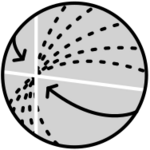Main Page
How it works
Make maps of culture
Concept: Maps transform the world
Maps began as communication between individuals.
(local, personal value)
Maps become tools of commerce.
(value for private collectives)
Overlapping projects discovered 'the globe'.
(shift in perception)
Maps became a public resource project
(accelerated influence, transformative function)
Activity: Relational Visualizations
(How do we take the transformative power of maps and utilize is to advance the human project? Here is a twist on a familiar tool.)
Culture = what we believe and what we do about it
(Judging action requires context. Culture is a concept for merging our actions with our context.)
Culture is a big project
Everybody's local maps (what they think and do) in a great big jumble. a feedback loop with a cycle of lifetimes big projects take massive coordination culture tends to be inexplicit it's hard to see enough to do anything it's hard to agree on what we are seeing
Data Science Visualizes the Collective
(math visuals)
Break it down into units
(cultural subdomains, ideas)
A 'social' 'map'
Make data relational. Example: a group's relationship with the idea of progress Example: a community map of relationship arguments
Study Collective Identity
Concept: The Journey to Wholeness
Identity is how we are known.
Like culture, it is some combination of what we do and how we do it. More than just a snapshot of what we think, identity is formed and refined through time and many iterations.
Individual identities are composed of parts that compete or collaborate
(Internal Family Systems)
The parts of our self can experience convergence or wholeness
(Internal Family Systems defines wholenss. This is a phase shift. This is a parallel to the shift in attention made when the world become a globe.)
Our collective identities are engaged in parallel processes
(country, religion, region, class, school, company, etc. Collective identities magnify our qualities; generate prosperity and or war.)
The journey between fracture and wholeness is our source of knowledge and meaning
(Example: the shift from systems of domination to mutual inquiry & discovery; enlightenment, science, democracy, free speech)
The most profitable journey's require new frames of reference
(Maps allow us to chart our journey. Example: accounting, economics, social analysis)
Novel frames of reference transform communication at scale
(Frameworks allow more nuanced ideas to become viral.)
Activity: Observing Patterns of Change
(Scope: individual cohorts learning about their collective self)
We take the map and make it part of a feedback loop
Q1: Who are we? How do we describe ourselves Q2: What do "we" do? So, actions but within that their variations... Intended/Unintended Harmonious/turbulent Aligned/Discordant
Change happen in certain ways
intended unintended, harmonious turbulent, simplification, elegance. There's what we want and what works and ways of moving from one to the other.
This sounds silly simple but how they are recorded and shared are a key aspect of the next phase: spreading insights through the population.
Human Programming Language
Concept: Open Source Social Algorithms
Change is a social process
(algorithms, social algorithms--government, science; complex social feedback loops)
Social processes that work spread
(genes -> memes -> knowledge -> technology)
Nobody wants to be programmed. Everybody likes a good program.
We are influenced at various scales. Some are scary (one world government, corporate monopoly, extractive social media algorithms). Some are foundational but ailing (education) Some are exploding in popularity (self-help, well being, courses, influencers).
Open process, collective ownership, global potential
(Open source, peer generated, algorithmic learning generates share resources, shared investment, public good, global aspirations)
We have the technology
for human wide communication (social media) for high leverage collaboration (github, wikipedia, polis) We can sort lots of ideas and allow the best to rise (science, virality, machine learning) humans solve problems (What is progress?)
We can put it all together
Global Social Technology Systems: Contextuality over uniformity (forking paths, if:then loops) repeatable process = forkable process data rich feedback loops Composability over central planning
Whole vision
Knitting together layers: social narratives that scale from the individual to the collective.
Activity: Running Human Code
Create common language
(Pick topics, Make maps)
Identify overlapping desire
(Observe convergence/divergence)
Coordinate Intentional Action
(Do something as a whole, together or in parts)
Revise Common Language
(Revisit core topics, propose new maps, chart our thinking. Refined frames are the seeds for new conversation.)
Devise algorithms
(experiment with patterns of change. Hypothesize, present, invite)
Iterate
(Start the process again, as needed until self sustaining patterns emerge)
Let the code run
(Repeatable process makes concepts testable, able to transfer to new groups or domains, spawns cultural translations, maps of knowing, becomes baseline for functional language for change.)

